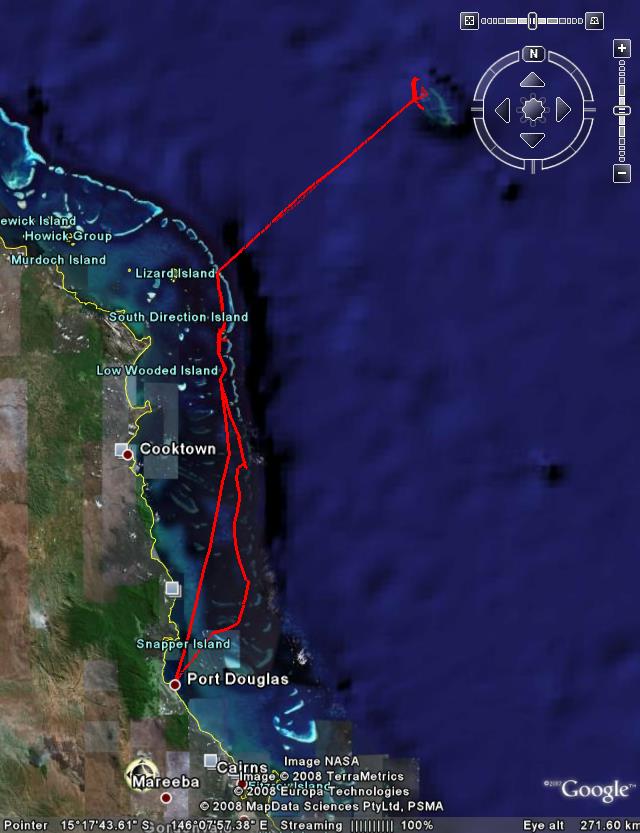
Map showing the path of the boat for the trip. Click on the map for a larger version with the dive sites marked.
This is an account of my sixth trip to the Great Barrier Reef and the Coral Sea aboard the Undersea Explorer. The Undersea Explorer mixes research and recreational diving for a truly fantastic experience. It is one of the few vessels that makes regular trips to Osprey Reef in The Coral Sea. For more information about the Undersea Explorer, please see their website at www.undersea.com.au.
This year I again travelled with Tim Everest. This was his second trip with Undersea. The crew were David (skipper), Sean (engineer), Daniel (divemaster), Heather (assistant divemaster), Gabriel (marine biologist), Florent (chef) and Emile (hostess). We had two researchers on board, Richard Fitzpatrick and Jonathan Werry, who both study sharks. Richard has been working with Undersea for a number of years and has been running the satellite tagging of tiger sharks at Raine Island (part of the Far Northern trips that Undersea run). There were 16 guests, in addition to Tim and me, from various countries: England, the Netherlands, Norway, Spain, Italy, Poland, Germany, Australia, South Africa, USA and Canada. It was a floating United Nations. It also demonstrates the reputation that Undersea has around the world.
This year I brought a GPS logger along so I could track the entire trip and mark each of the dive sites. The logger is a Holux M-241 which works quite well but the internal AA battery only lasts up to 12 hours. The logger uses a USB cable to communicate with a PC and the cable can also be used to power it. I bought a USB power adaptor that takes 4x AA batteries and used that to power the logger and changed the batteries once per day.
A major problem with this trip for me was that I came down with the `flu on the Tuesday before the trip. I was hopeful that I would recover enough before the trip but it was going to be touch and go.

Map showing the path of the boat for the trip. Click on the map for a larger version with the dive sites marked.
I arrived in Port Douglas at around 3pm, feeling quite unwell. Tim had travelled up on an earlier flight and I met with Tim soon after I arrived. I dropping off my gear at the office and we headed into town for some supplies (soap, sunscreen and beer). The purchase of the beer was in anticipation of me recovering enough to drink alcohol again.
We got back to the boat just before 4pm and all our gear was on board. We unpacked our dive gear and registered with Daniel, the divemaster. After registration, we headed back to the Court House Hotel for some dinner and the returned to the boat before 7pm for the skipper's briefing and to get underway. David (the skipper) took us through the regular stuff about the boat including the safety guidelines.
Just after 7:30pm, Tim and I set up our loggers (Tim had one, too), in the wheelhouse and started them logging. The boat left Port Douglas just before 8pm. We were really on our way.
We arrived at Ribbon Reef #10 just after 8:30am and moored at Pixie Gardens ready for the first dive. The trip had been pretty good as we were protected behind the Ribbon Reefs as can be seen from the route map above. I managed to get some sleep despite still feeling unwell.
Before the first dive, Daniel gave us an introductory briefing covering the rules and guidelines for diving on Undersea Explorer. This was a mix of Queensland Government regulations as well as sound ecotourism principles like not touching the corals. Daniel then provided what would be the first of many dive site briefings.
The first dive of the day was at Pixie Gardens at the southern end of Ribbon Reef #10. I geared up with everyone else, jumped into the water, but soon found that my chest was not yet ready for the compressed air. I had trouble breathing and was worried I would have a coughing fit if I descended and so I aborted the dive. Tim had to find someone else with whom to dive. It was very disappointing. I hear the dive was good, too.
After a hot breakfast we headed off towards Challenger Bay for the second dive of the day. While in transit to the site, we were followed by a couple of dwarf minke whales. They followed us for a while and it appeared they would hang around. We moored at Pixie's Reef and the crew put out the snorkel lines so we could hopefully swim with the whales. Unfortunately, they did not stay and there was no interaction. Everyone else went for a dive at Pixie's Reef but I sat it out.

Snorkellers on the snorkel lines, hoping for minke whales.
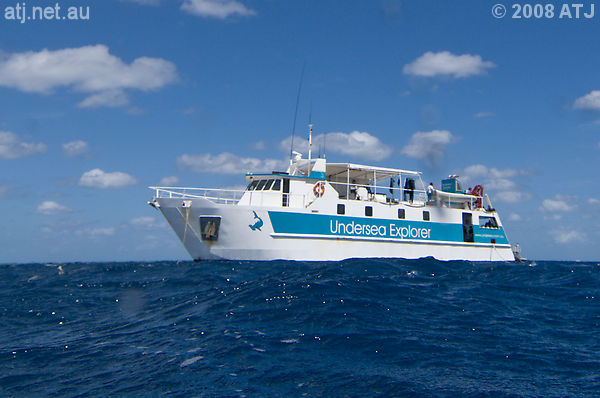
Undersea Explorer as seen from the water.
The third and fourth dives of the day were at Challenger Bay, with the latter being a night dive. I have dived at this site before and have enjoyed it, especially the night dive, but as I was still feeling unwell, I thought it was better to sit them both out and I even had a bit of a sleep.
We had dinner and then just after 8:30pm we headed off to Osprey Reef. I headed off to bed in the hope of being asleep before we hit open water. Challenger Bay is at the southern end of Ribbon Reef #10 and so we travelled behind, and were protected by, 30 kilometres of reef. Once we hit the northern end of Ribbon Reef #10, we passed through to the outside of the reef and the trip got a whole lot rougher. This was just after 10:30pm and sleeping became very difficult, especially with my 'flu.
We arrived at Osprey reef at around 9:30am. The trip over had been quite rough, however I managed to get some sleep and I was feeling a little better. My head was not aching as much nor was my throat but my chest still felt heavy.
The first dive of the day was at Admiralty Anchor. The site is named for an old style (admiralty) anchor embedded in a swimthrough. I wasn't sure how I would go so I geared up, went down the safety chain and hung at 5 metres for 5 minutes to see how I felt. I did OK, so I went for a 20 minute dive with Sean, the engineer and felt pretty good. We went through the swimthrough and I actually saw the anchor for the first time. That would have been around my 10 time through the swimthrough and yet previously I had not seen the anchor. Dive details
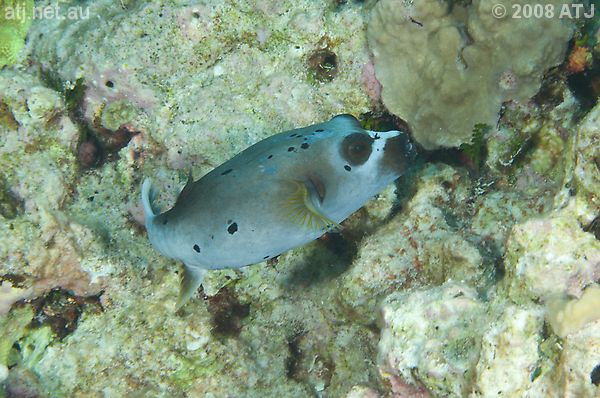
Black-spotted puffer, Arothron nigropunctatus at 4.1 metres at Admiralty Anchor.
After the dive the boat headed into the lagoon to pick up some data loggers which are used for tracking sharks around Osprey Reef. Many of the sharks are tagged (on previous trips) and when the tagged sharks come into vicinity of the loggers, they are logged. This can be used to determine how much the sharks move around Osprey Reef.
The second dive of the day was at North Horn. This was a better dive for me to check out how I was feeling and I managed to stay in for the full term of the dive. Dive details
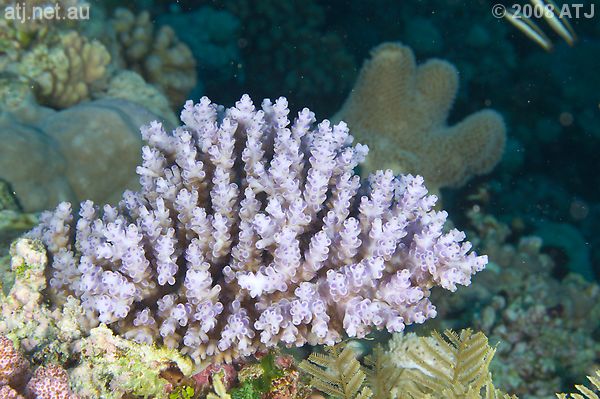
An Acropora sp. colony at 7.4 metres at North Horn.
After the second dive, Richard Fitzpatrick and Jonathan Werry did a spot of shark wrangling. Basically, they tie tuna heads to a rope, throw them over the back of the boat and when a shark grabs the head, drag the shark (usually a grey reef whaler, Carcharhinus ambylrhynchos) onto the duckboard at the back of the boat for measuring. While we watched they managed to catch 3 grey reef whalers.
Before the night dive, Gabriel took a couple of guests out in the tender to drop the Nautilus traps. On each trip to Osprey Reef, Undersea drops Nautilus traps off Admiralty Anchor to catch Nautilus for measuring, tagging and release (the following night). Over the years they have caught nearly 3,000 different Nautilus and because of the tagging are able to identify recaptures which happen regularly. The traps are lowered on rope to a depth around 300 metres. The Nautilus live in deeper water during the day but ascend to around 300m at night to feed. The traps are baited with pieces of chicken which appears to work quite well in attracting the Nautilus.
With the late arrival at Osprey Reef and all the other activities on the day, we only had time for 3 dives. The night dive was back at Admiralty Anchor. I was determined to find and photograph the basket star which sits in the same place each night and which I have seen on 3 of the last 5 trips. Interestingly, on my first ever trip to Osprey Reef in 2002, I was able to find the basket star on my first attempt (after receiving good directions from the divemaster). Subsequent trips I was not as fortunate and needed help. On this trip the dive master didn't even mention the basket star. I knew exactly where to look and found it in a few minutes. It was not full open, but I still managed some shots. Dive details
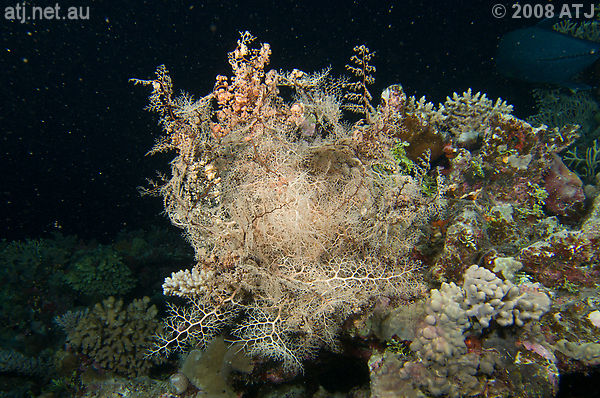
The basket star, Astroboa nuda, at Admiralty Anchor.
The boat stayed moored at Admiralty Anchor for the night. After dinner, Richard and Jonathan did some more shark wrangling. I was tired and so went to bed early, but I do remember hearing them yell out that they'd caught a silvertip, Carcharhinus albimarginatus. I thought about getting up for a moment before drifting off to sleep.
After a more peaceful night's sleep I was feeling even better on day 3.
Just after dawn, Gabriel and two guests went out to retrieve the Nautilus traps. It had been a good night with 12 animals caught including one recapture. The animals were placed in a cooler with some ice to keep the water cool until later in the day when they could be measured, logged and engraved.
The first dive of the day was at Raging Horn. Raging Horn has a cleaning station that is frequented by both sharks and manta rays and we were hopeful of seeing some mantas. The boat dropped us off at a buoy above the other end of a spur from the cleaning station. We descended the line under the buoy and then swam to the cleaning station. There were no mantas there but there was a scalloped hammerhead, Sphyrna lewini, (my first one ever and a silvertip shark, Carcharhinus albimarginatus, (also a first for me) and some grey reef whalers. As I viewed the hammerhead from the side I noticed how odd it looked. The tail and body looked like a normal shark (although the dorsal fin looked higher) but the head area looked like a big mistake. I think this was because the head was side on so that the lateral expansions were pointing directly to me. Dive details
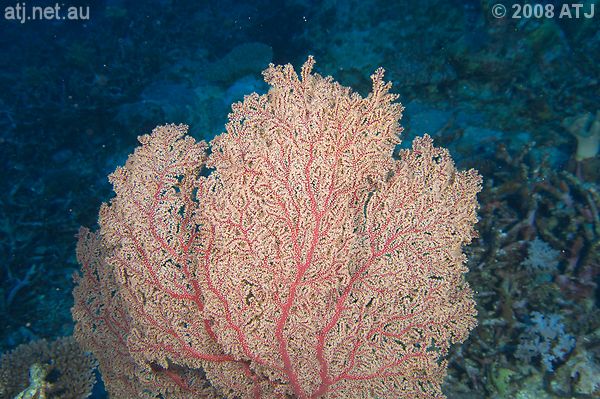
A sea fan at 31.6 metres at Raging Horn.
The second dive of the day was at North Horn. As I was feeling better, I thought I would try to find a weedy scorpionfish, Rhinopias aphanes, I has seen in 2003. I couldn't remember the exact spot but searched around an area which I think was close but didn't find it. I was able to watch a grey reef whaler, Carcharhinus ambylrhynchos, being cleaned. It hung vertically in the water while fish cleaned it and it slowly descended as sharks have no swim bladder. The behaviour is not often witnessed. I was also lucky enough (along with most of the other divers) to see a large school (20+ individuals) of scalloped hammerheads, Sphyrna lewini. Dive details
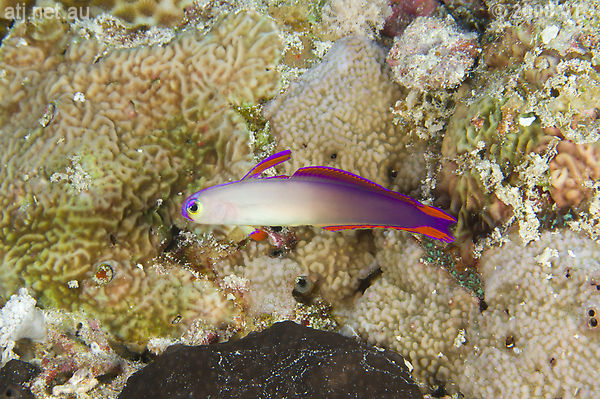
A purple firefish, Nemateleotris decora, at 30.2 metres at North Horn.
The third dive of the day was at North Horn again, but this time it was to attract sharks. The crew place crates containing fish heads which brings the sharks in but they don't get fed. We saw a large number of white tip reef sharks, Triaenodon obesus, a large number of grey reef whalers, Carcharhinus ambylrhynchos, and one large silvertip shark, C. albimarginatus. Dive details
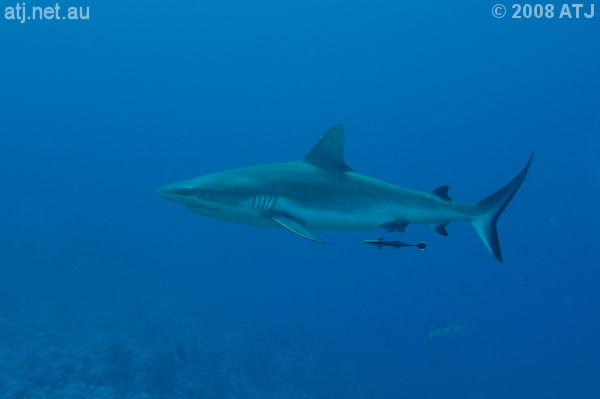
One of the many grey reef whalers, Carcharhinus ambylrhynchos, seen on the dive at North Horn.
During the day, Gabriel enlisted support from guests to help with processing the Nautilus. Each animal was measured, logged and engraved with a unique number. The engraving is in the shell and does no harm to the animal.
The night dive was at Admiralty Anchor again. I thought it better to miss that dive and rest up a bit. The Nautilus were released during the night dive.
We had dinner and the boat left for the Ribbon Reefs just after 9pm.
Overnight we spent another rough ride from the Coral Sea back to the Great Barrier Reef, arriving at The Cod Hole just after 8am. I slept better this time, more so because I was starting to get over the 'flu.
The first dive of the day was at The Cod Hole, famous for its large and friendly potato cod, Epinephelus tuluka. I used my Tokina 12-24mm lens on this dive to get some cod photographs. I also used the +4 diopter on the lens to help get close to some subjects which was luck as a cuttlefish, Sepia sp., was found. Dive details
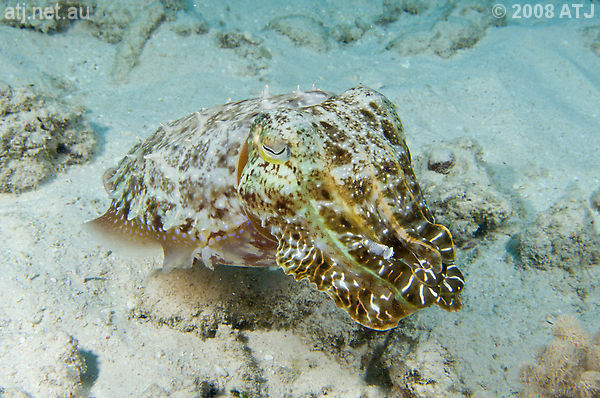
The cuttlefish, Sepia sp., at 7.5 metres at The Code Hole.
The second dive was at Lighthouse Bommie. I think I may like Lighthouse Bommie even more than Steve's Bommie because there is such a wide range of organisms here. On previous trips I have heard about the sea snakes but not seen any. This time I saw two olive sea snakes, Aipysurus laevis, one sleeping and the other swimming around. I also saw between 11 and 14 lionfish, Pterois volitans. I can't be certain that I didn't see the same three twice, but there were 8 in one spot. I also saw pipefish and longnose hawkfish, Oxycirrhites typus. Dive details

One of the lionfish, a juvenile, Pterois volitans, at 10.2 metres at Lighthouse Bommie.
The third dive was at Pixie's Pinnacle, which is another favourite of mine but I was feeling a little unwell and sat the dive out.
The night dive was at Pixie Gardens and I also passed on that dive.
Overnight the boat travelled from Pixie Gardens at the bottom of Ribbon Reef #10 to Clam Gardens on Ribbon Reef #5. As it was a relatively short trip we didn't leave Pixie Gardens until around 2am and arrived at Clam Gardens at around 7am.
The first dive of the day was at Clam Gardens. As might be expected from the name, this site has a lot of clams, in particular giant clams, Tridacna gigas. Dive details
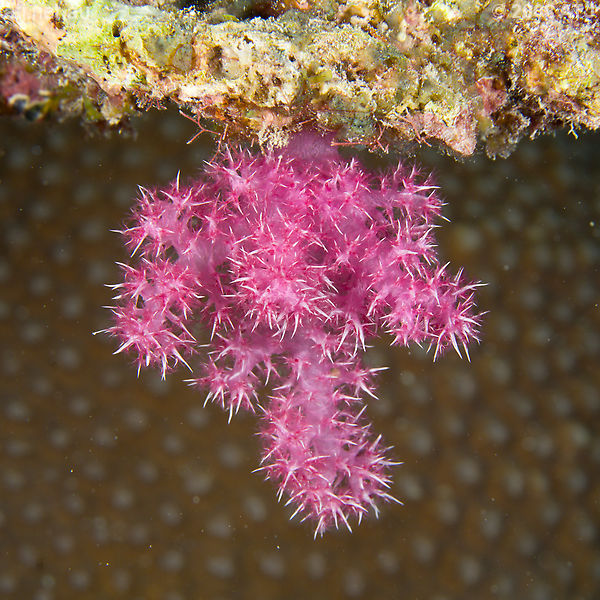
Nephtheid soft coral, probably Dendrohephthya sp., at 12.4 metres at Clam Gardens.
The second dive of the day was at a Pavona Clavus, so named because of the colonies of a stony coral called Pavona clavus. The highlight of the dive was seeing numerous pairs of red-line cleaner shrimp, Lysmata amboinensis. Dive details
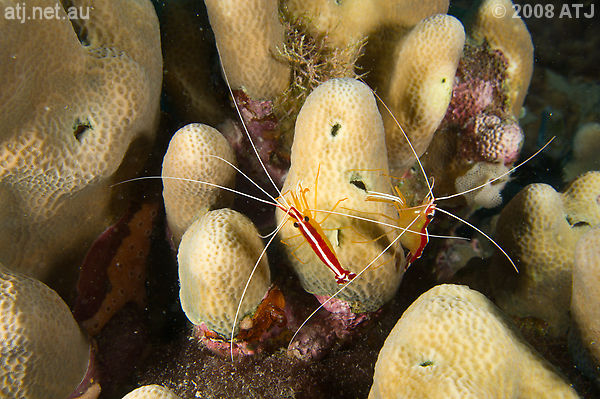
A pair of red-line cleaner shrimp, Lysmata amboinensis, at Pavona Clavus.
On our way to the third dive site for the day, Steve's Bommie, a couple of humback whales were spotted and we followed them for a few kilometres. We got as close as 50-100 metres from them and they put on a performance including leaping almost completely out of the water and smashing the water with their tails. It was fantastic to watch.
After the humpback whales, we headed back to Steve's Bommie for the third dive. Steve's is renowned for good macro subjects so I went with the 60mm macro lens and flat port. We saw a number of species of anemonefish, including two clown anemonefish, Amphiprion percula, in an anemone on top of the bommie. Last year the same anemone only had one. We also saw some lionfish and at least one stonefish. Dive details

One of the clown anemonefish, Amphiprion percula, on top of Steve's Bommie.
The night dive was also at Steve's Bommie and I went with the 60mm lens and flat port again for some more macro work. I dived with Gabriel, the marine biologist for the boat, and he pointed out a lot of interesting organisms, including numerous, flatworms for me to photograph. There was a large lionfish, Pterois volitans that followed us for much of the dive and kept getting in the way. There were also at least two basket stars, Astroboa nuda, but as I had the macro lens, I was only able to photograph small parts of them. Dive details
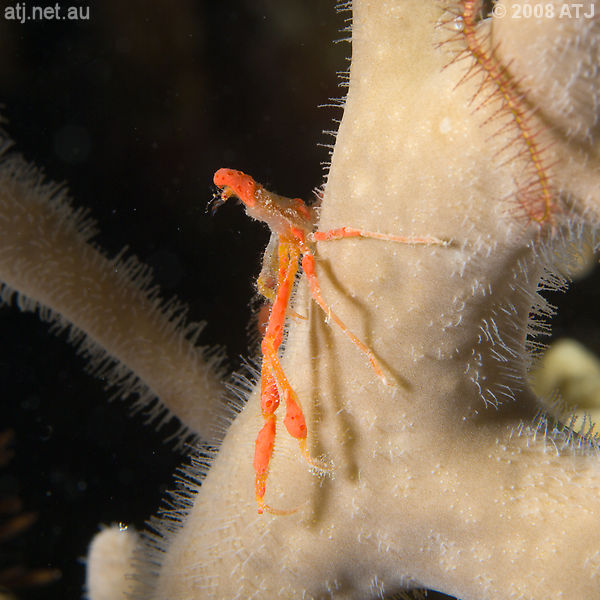
Spider crab, probably Oncinopus sp., at 11.5 metres on the night dive at Steve's Bommie.
While the dive at Steve's Bommie was generally uneventful, there was a bit of drama occurring above the water at the same time. At around 18:55 (25 minutes into the dive for me), the boat broke its mooring and drifted away from the dive site. Luckily, the crew on Undersea Explorer handled the situation very well and did what was necessary to get the boat back into the vicinity of the site so the tender could be used to collect the divers, including me. The map below shows the course of the boat from the time the dive started (18:30) through until I was picked up at around 19:30 as recorded by my GPS logger. Just some of the waypoints are shown. The white horizontal line below the route represents 200 metres so the boat got around 400 metres from the dive site. I ended up hanging on to the buoy attached to the top of Steve's Bommie for 8 to 10 minutes and was never really in danger. Once again, the crew handled the situation very well.
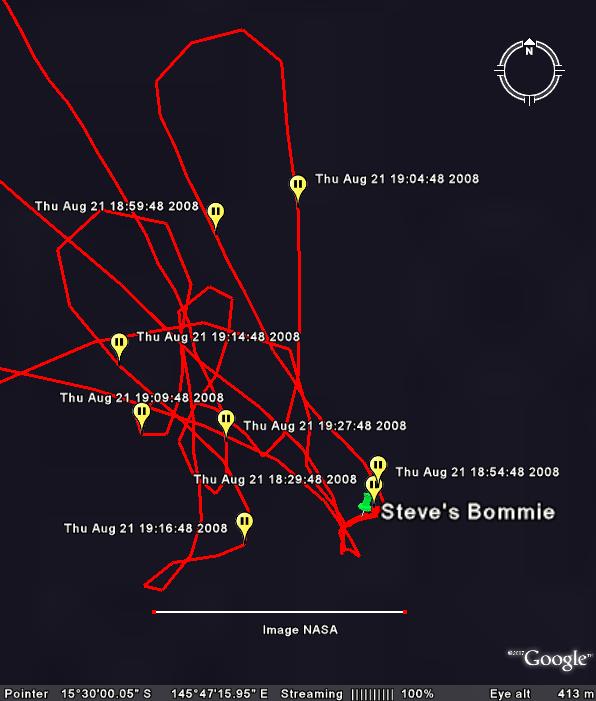
Route map from GoogleEarth showing the route of the Undersea Explorer before, during and shortly after the night dive.
Again, we had a short overnight trip from Steve's Bommie on Ribbon Reef #3 to Agincourt Reef. We left Steve's (well the area around Steve's as we had broken the mooring) at around 2am arriving at Agincourt Reef at around ten minutes past 7am.
The first dive on the last day was at Nobody's. Robert (my buddy for the dive) and I spotted quite a lot of beautiful nudibranchs which made for a very pleasant last dive. Dive details
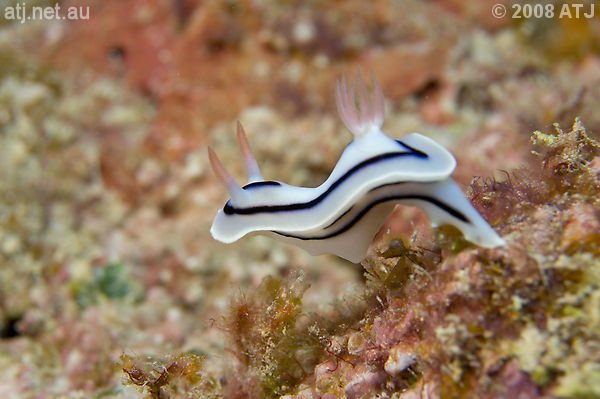
Nudibranch, Chromodoris lochi, at 10.1 metres on Nobody's.
The last dive of the trip was at G Spot. Normally, I would not give up this last opportunity to dive in tropical waters but as the dives on the last day are typically live pickups (i.e. the boat is not moored), I disassembled the camera rig after the previous dive, only to find out later we would moor. As I still didn't feel 100%, I gave this dive a miss.
After the dive we started the journey back to Port Douglas. We left G Spot at around 1pm and would be travelling for around 4 hours. We passed the time by washing our gear, packing, settling our accounts and sitting around. We arrived at Port Douglas at 5pm. The diving trip was at an end. We still had to spend the next 15 hours or so in Port Douglas before travelling back to Cairns for the flights back to Sydney.
The staff from Undersea Explorer ferried everyone to their overnight accommodation - or to the bus for those travelling to Cairns. Tim and I were staying at Parrotfish Lodge again. Robert joined us, too, so we shared a room. This was convenient for Tim and me because Parrotfish had somehow lost our reservation. After showering, I headed out to meet with a friend from University who now lives in Port Douglas and Tim and Robert went down to the Court House Hotel. Louise and I ate dinner at the Sailing Club and caught up with what had been happening in our lives over the last year. It was a great evening and she dropped me back at Parrotfish around 9:30 pm. I was still wide awake so went down to the Court House and found Robert and Tim who had met up with Marius and Maryanne (fellow guests from Undersea). After the Court House closed for the night we went off to the Iron Bark. After an enjoyable night it was time to call it quits and we headed back to Parrotfish for a good sleep - in beds that weren't moving.
In the morning, Tim and I farewelled Robert who was heading up the Daintree Rainforest, we checked out and caught the bus to Cairns. After an uneventful flight back to Sydney, the trip was really over.
Despite being sick and frustrated because of being sick, I had an enjoyable trip. The highlight was definitely the 20-30 hammerhead sharks we saw at North Horn. I was disappointed that I only got 13 dives in, but the dives I had were great. I am anxiously waiting for the next trip.
Last updated: 18 September 2008